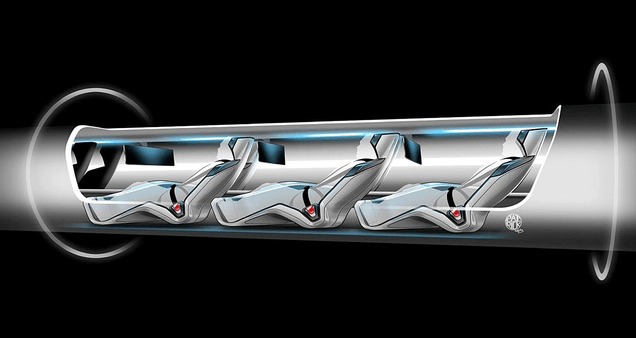Whereas a conventional train will take around two and a half hours for the same distance. A Hyperloop is a proposed mode of passenger and/or freight transportation, first used to describe an open-source vactrain design released by a joint team from Tesla and SpaceX. Drawing heavily from Robert Goddard’s vactrain. A hyperloop is a sealed tube or system of tubes through which a pod may travel free of air resistance or friction conveying people or objects at high speed while being very efficient.
There are two big differences between Hyperloop and traditional rail. The pods carrying passengers travel through tubes or tunnels from which most of the air has been removed to reduce friction. This should allow the pods to travel at 1000 km per hour or more. Rather than using wheels like a train or car, the pods are designed to float on air skis, using the same basic idea as an air hockey table, or use magnetic levitation to reduce friction. Several different companies are working to turn this idea into a functioning commercial system [2].

Figure: A Hyperloop pod showing seating arrangement of passengers
Is Hyperloop safe? Safety is the number one priority for any new transport system involving human life. It seems that Hyperloop to be inherently safer and more reliable than maglev or high-speed rail. As there will be no at-grade crossings (by far the leading risk posed by trains), so there are no interactions with other forms of transport or wildlife. The working principle is the same as that of a maglev train i.e. the train is levitated and propelled forward using powerful electromagnets. As the pod will run through a tube, so chances of collusion are very less.
One of the main challenging issues surrounding Hyperloop is the financial aspect. Undertaking a project like the proposed Hyperloop can be a large financial burden. It is already anticipated that the 560-km trip between Los Angeles and San Francisco will cost $20 each way. However, to build the extravagant tube system, Musk estimates it costs will be between $6 billion and $7.5 billion.
Virgin Hyperloop One is one of the leading contenders attempting to create a commercially viable Hyperloop system. It was founded in June 2014 and has over 300 staff, and has raised $295m intending to build an operational system by 2021 [3].
The commercially available Hyperloop system will high on performance. Five minute station times, top speeds of 1000 km per hour, isolated internal tube environments, and a capacity of 840 passengers per hour make the Hyperloop the fastest, safest, and most efficient mass transportation system ever proposed.
References:
1. Langridge M Better E. What is Hyperloop? The 700mph subsonic train explained. 13 October 2017. [Assessed from: https://tinyurl.com/y4phphlc].
2. Grant M. Hyperloop Vs. High-Speed Rail Travel: What’s the Difference? Jul 22, 2019. [Assessed from: https://tinyurl.com/y44c477j].
3. Ranger S. What is Hyperloop? Everything you need to know about the race for super-fast travel. March 15, 2018. [Assessed from. [https://tinyurl.com/yxeh5rdd].
Source of image: https://tinyurl.com/y4phphlc
Dr. Sanjoy Kumar Pal is a Professor of Biology in Skyline University Nigeria. He has a PhD. in Animal Genetics from Indian Veterinary Research Institute, India.
You can join the conversation on Facebook @SkylineUniversityNG and on Twitter @SkylineUNigeria
